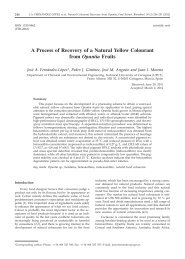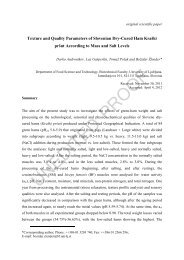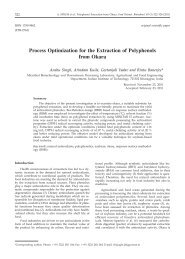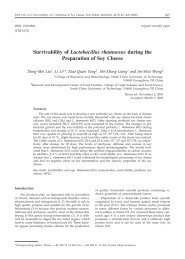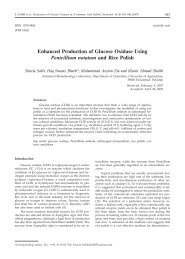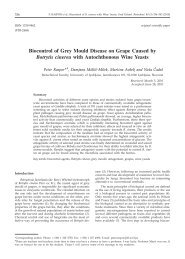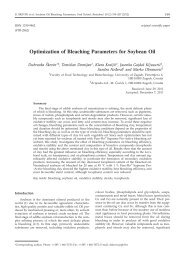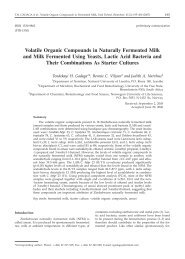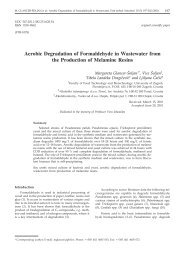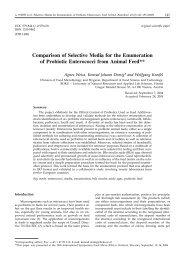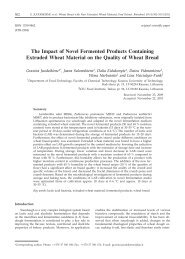Surfactin - Food Technology and Biotechnology
Surfactin - Food Technology and Biotechnology
Surfactin - Food Technology and Biotechnology
- No tags were found...
You also want an ePaper? Increase the reach of your titles
YUMPU automatically turns print PDFs into web optimized ePapers that Google loves.
130 N.S. SHALIGRAM <strong>and</strong> R.S. SINGHAL: <strong>Surfactin</strong> – A Review, <strong>Food</strong> Technol. Biotechnol. 48 (2) 119–134 (2010)the case of antibiotics. One disadvantage of this methodis that it cannot be used in systems with high proteincontent due to competitive binding of proteins. Combinationof surfactin with enrofloxacin exhibited a synergisticeffect <strong>and</strong> resulted in mycoplasma-killing activityat about two orders of magnitude higher than those ofthe individual molecules used (73).Effect of surfactin on the cell membranes<strong>Surfactin</strong> shows 'detergent-like' action on cell membranes(74). The term 'detergent like' was used due to itsunspecific mechanisms of membrane permeabilization.Detergents act by inducing curvature in membranes,causing disorder of the acyl chains, a decrease in membranethickness <strong>and</strong> lateral packing density with loss ofmembrane stability. <strong>Surfactin</strong> tilted the acyl chains, withits peptidic portion inserted into the hydrophobic interfaceof the membrane. The activity of surfactin wasquantified in terms of product partition coefficient <strong>and</strong>CMC. Surfactant to lipid molar ratio was also an importantfactor, which was required for the membrane solubilization.Detergent-like action was found to be temperature-dependentwith an increased surfactin activity beingobserved at lower temperature. It was proposed that atlower temperature membranes were more ordered <strong>and</strong>hence were more sensitive to a disordering agent. Theadvantage of surfactin was that it exhibited membrane--permeabilizing effect at concentrations much below theCMC values (75).Atomic force microscopy (AFM) combined with surfacepressure-area isotherms has been used to probe theinterfacial behaviour of phospholipid monolayers followingthe penetration of surfactin (76). It was observedthat the increase in the phospholipid chain lengthsmakes insertion of surfactin into the lipid membranedifficult. Electrostatic repulsions created by the presenceof a negative charge on the phospholipid polar headprevented the peptide cycle from coming close to thephospholipid headgroups. The presence of salt decreasesthe electrostatic repulsion between the adsorbed moleculesin favour of hydrophobic interactions. The penetrationprocess is mainly governed by hydrophobic interactionsbetween the fatty acid chain of surfactin <strong>and</strong> thephospholipid chains in the presence of salt. AFM imagesobtained for these systems indicated that the presence ofa negative net charge in the phospholipid monolayerpromotes the immiscibility between the interfacial components.<strong>Surfactin</strong> adsorption onto a monolayer-free interface<strong>and</strong> its penetration into a lipid film is affected by thelength of the lipopeptide chain <strong>and</strong> the nature of thepeptide moiety. It was observed that the longer the surfactinacyl chain, the better its insertion into the lipidlayer. This indicated that hydrophobic interactions areimportant for the penetration power of surfactin. Thepresence of a cyclic polar head (in contrast with a linearone) also favours surfactin penetration into a dipalmitoylphosphatidylcholine(DPPC) monolayer. It was proposedthat linear surfactin mainly adopts a r<strong>and</strong>om coilconformation in the subphase, favouring a faster diffusionto the interface. At the interface, cyclic moleculeswith a rigid conformation have a reduced degree offreedom, resulting in rapid interfacial rearrangement.Cyclic surfactins at the interface are most likely to adopta conformation in which the fatty acid chain is foldedon the peptide ring. This folding is governed by the increasedintramolecular hydrophobic interactions withlipopeptide chain length (76–78).These observations provide an insight with respectto the interaction of surfactin with the lipid membranes.First, under physiological conditions, surfactin penetratesinto cellular membranes independent of their phospholipidnature. The cyclic nature of the peptide moiety<strong>and</strong> the fatty acid chain length play an important role inthe lipopeptide activity. Second, negatively charged phospholipidspromote immiscibility of surfactin into the lipidmatrix favouring surfactin self-assembly formation,which is the basis of pore-forming activity. Therefore, itwas suggested that surfactin, like other antimicrobialpeptides, exhibits a target selectivity behaviour based onthe composition of the lipid matrix of the target cell. Inparticular, the lipopeptide could display a high pore--forming activity for membranes with a considerablyhigh amount of anionic lipids such as bacterial membranes,aged blood erythrocytes, <strong>and</strong> some cancer cells(78–80).The molecular mode of action of the lipopeptidesurfactin with zwitterionic <strong>and</strong> negatively charged modelmembranes has been investigated with solid-stateNMR, light scattering, <strong>and</strong> electron microscopy (81). Amechanism for small vesicle formation by a two-step actionwas proposed: (i) peptide insertion into membranesbecause of favourable van der Waals forces between thelipophilic part of surfactin <strong>and</strong> lipid chains, <strong>and</strong> (ii) electrostaticrepulsion between the like charges of lipid headgroups <strong>and</strong> the negatively charged surfactin amino acids.The phenomenon has been observed for membranemixtures containing phosphatidylglycerol or phosphatidylserine.Heerklotz <strong>and</strong> Seelig (82) reported the leakage <strong>and</strong>lysis of palmitoyloleoylglycerophosphocholine (POPC)vesicles induced by surfactin using calcein fluorescencedequenching, isothermal titration calorimetry <strong>and</strong> 31 Psolid-state NMR. There are different mechanisms bywhich detergents can permeabilize membranes: (i) thebilayer-couple model (83) describes the effect of detergentsthat cannot flip quickly from the outer to the innermonolayer; (ii) at higher detergent concentration, detergent-richclusters in the membrane become abundant,which destabilizes the lamellar structure <strong>and</strong> results inleaks by covering their edges with a detergent-rich rim;(iii) at a characteristic detergent-to-lipid ratio in themembrane, Rsatb , the lipid membrane starts to becomesolubilized to mixed micelles. Membrane leakage startsat a surfactin-to-lipid ratio in the membrane, R b »0.05, <strong>and</strong>an aqueous surfactin concentration of C Sw »2 mM.Anti-adhesive applicationColonization of a surface by bacteria causes nosocomialinfections (84). Swarming motility <strong>and</strong> biofilmformation are the two reasons responsible for colonizationof bacteria. Biosurfactants possess anti-adhesiveproperties, which inhibit the adhesion of bacteria ontothe surface or infection sites. These infections share commoncharacteristics even though the microbial causes <strong>and</strong>




